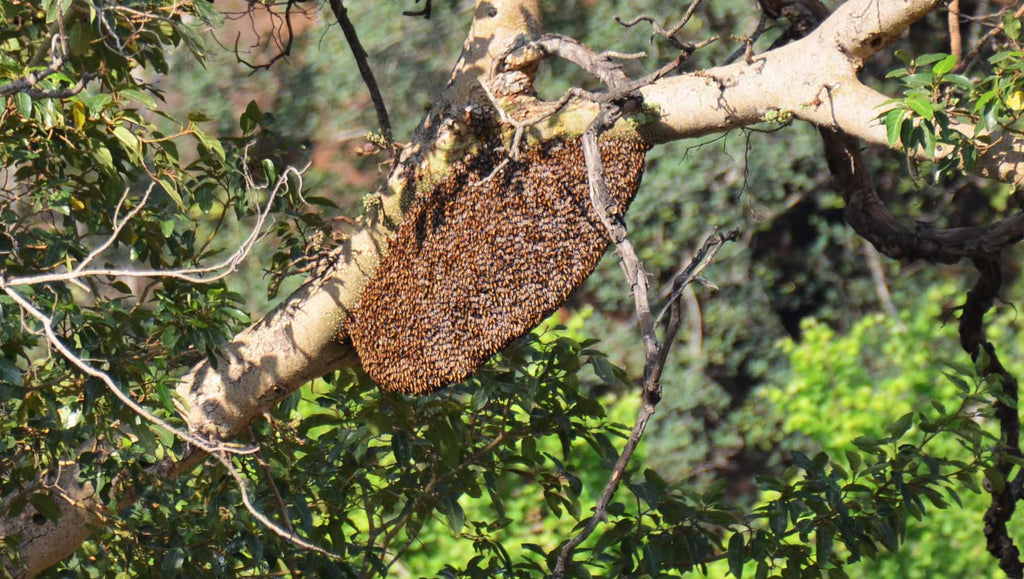
After returning from the wedding, we spent the night resting at the guest house. The next morning, we, along with our team member Durksha, went to Kumhri village and enjoyed morning tea with the villagers. It was now time to descend into the deep valleys of Patalkot, where, according to our team’s survey, honey is found in abundant quantities.

Together with our six-member team—Durksha, Ramlal, Hanuman, Ballabh, Yogeshwar, and Arjun—Vikas and I set out toward the valleys, fully equipped with kit bags and all preparations. Although we had climbed and descended hills many times before, this was our first experience of descending into valleys whose depth, from Kumhri village atop the hill, was approximately 2,000 meters.


While descending through the rocky paths and black boulders, we had to be extremely careful, as even a slight slip could send us tumbling into the valleys below at the first landing.


Keeping ourselves safe with caution, we moved together toward the valleys, and after descending approximately 500 meters, we reached a temple nestled among the dense hills, known as Amma Mai Temple, situated amidst a small settlement of two or three houses.


Among the tribals, it is believed that before descending into the valleys, one must first visit the Amma Mai Temple to seek the permission and blessings of the goddess installed there. The mesmerizing view there made us want to shake off the fatigue of the journey, so we sat under the shady trees in the temple courtyard to rest. Then the thought came—why not share such a sight with you? We took out the camera and began capturing photographs of the temple courtyard, the ancient deity sculptures, and the lush green hills surrounding it.
As we continued, our eyes fell on water falling from a pipe-like structure. It was neither a tap nor an electric water device. Upon closer inspection, we discovered that the pipe was connected to a thin tunnel in the hill, through which a tiny stream of water flowed into a tank below. When we asked the villagers, they revealed that the origin of this stream remains a mystery to this day. This stream serves as the only source of water for drinking and other household needs for the settlement. Whether it is divine grace or a secret of nature, we could not comprehend, but it left us in awe.

Well! After such a long journey, our throats were dry. Since we were in the temple courtyard, we took off our shoes and went to the pipe to quench our thirst. Although we had carried water with us, the joy of drinking from such a unique stream could only be experienced by cupping the water in our hands. The coolness of the water felt like a jolt of electricity running through our bodies, and its sweetness compelled us to drink even after quenching our initial thirst.

After resting, we once again began descending into the valleys. After covering some flat terrain, we had to navigate the same rocky paths. In the scorching afternoon sun, a tribal man noticed us passing by and asked about our presence. When we explained that we had come in search of honey and to learn about Ayurveda, he informed us that a large honeycomb was located on a wild fig (Gular) tree just a short distance from his home. Grateful for Amma Mai’s blessings, we thanked him and proceeded with him to the tree. Without wasting any time, the team members put on their safety kits and prepared to extract the honey.

Just as our team member Ramlal climbed the tree and reached near the honeycomb, two elders from the settlement arrived and politely urged us not to extract the honey at that time. Since the tree was close to the village, the bees could harm children and animals. They suggested that we wait until evening, as in the hill settlements the dimming light at that time reduces the risk, and the bees cause less harm. Respecting their request, we agreed and asked Ramlal to come down from the tree.

By then, we no longer had enough time to descend into the valleys, extract the honey, and return to Kumhri while it was still daylight. After such a long journey, we couldn’t go back empty-handed, so we decided to postpone the honey extraction in the valleys for the next day. Meanwhile, we sat in the temple courtyard, talking with the villagers and waiting for evening. So engrossed were we in their conversations that we didn’t even notice when the evening arrived.
Immediately, we had Ramlal put on his safety kit and climb the tree, while the rest of the team prepared for the extraction. The honeycomb of the bees was massive and thick, yielding approximately 27 kilograms of honey—a quantity rarely seen.

Having achieved such success at the very beginning of our journey, smiles of joy lit up all our faces. By now, it was quite dark, and returning to Kumhri through the dense forests in such darkness could have posed a serious risk for us.

Since the villagers frequently traveled to Kumhri, they were already familiar with our team members, and in the short time, we had also built a familial bond with them. They insisted that we have our dinner and rest at their home for the night. Considering it a great honor, we gladly accepted their invitation and stayed at their home to rest.

For dinner, we had a simple yet hearty meal of hot rotis cooked on a clay stove, ghee, chutney, and rice with Kutki dal. Nestled in the valleys, in that small settlement, we spent the night resting amidst the cool, fragrant breeze.

That’s all for today’s blog. We will soon return with the next post, sharing invaluable experiences from the mysterious land of Patalkot. Until then, stay with us!
